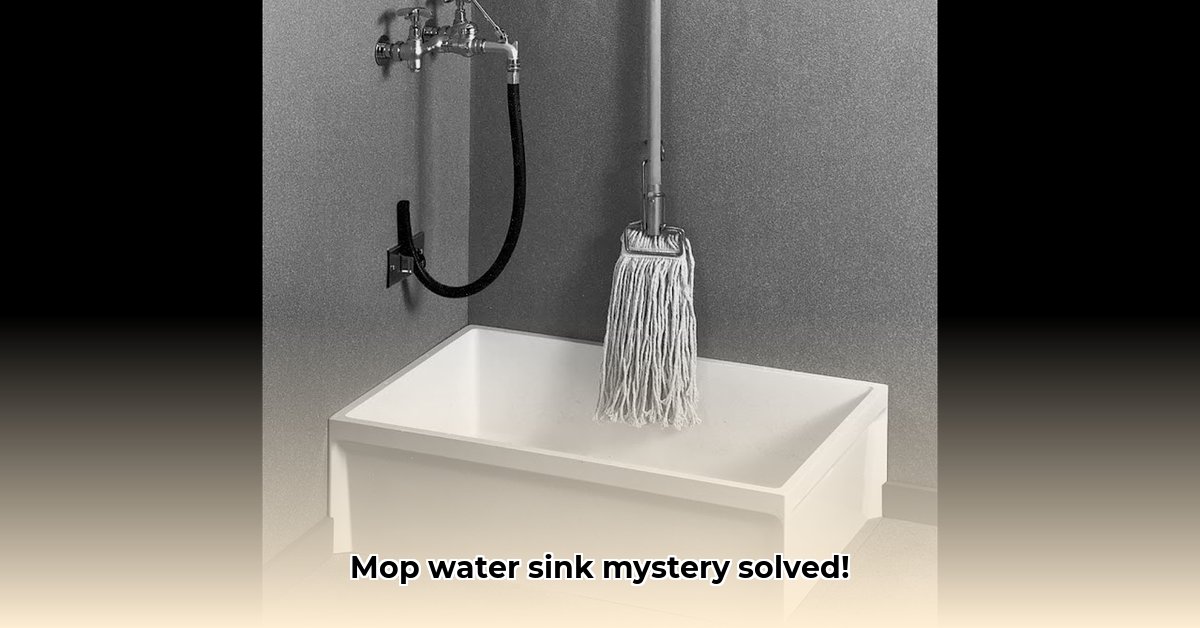Ever wondered where to dump that grimy mop water after cleaning your floors? It might seem insignificant, but using the wrong sink can clog your pipes and create a real mess. This instructional guide will show you the best way to get rid of mop water safely and efficiently. We’ll explore different types of sinks suitable for mop water disposal, from dedicated mop sinks to regular utility sinks and consider even outdoor options while highlighting potential environmental concerns. We’ll also cover how to prevent clogs, maintain cleanliness, and adopt eco-friendly practices. Let’s ensure your mop water disposal is quick, easy, and problem-free, enhancing your home’s hygiene and preserving your plumbing!
Which Type of Sink is Used for Dumping Mop Water? Choosing the Right Disposal Point
Mopping floors can be a chore, but dealing with the dirty mop water afterward shouldn’t add to the burden. Where should you safely dispose of it to avoid plumbing dilemmas? Understanding the appropriate sink types is crucial. Choosing the wrong place can lead to plumbing nightmares and even health risks. Let’s find the best solution to responsibly manage your mop water.
The Dangers of Dumping Mop Water Just Anywhere and potential plumbing nightmares
That bucket of dirty water isn’t just water—it’s a cocktail of dirt, hair, cleaning chemicals, and potentially germs. Pouring this into your regular kitchen or bathroom sink increases the risk of clogs, leading to expensive repairs and unpleasant backups. Moreover, it fosters an environment for bacteria growth, posing a contamination risk, especially near food preparation areas.
The Best Solution: A Dedicated Mop Sink, the ultimate choice
For the ultimate solution, especially if you mop frequently or have a large area to clean, consider a dedicated mop sink. You’ll often find these in commercial kitchens and larger homes. These heavy-duty sinks are built to handle large volumes of dirty water and debris. They typically feature a spacious, shallow basin and a generously sized drain, significantly reducing the chance of clogs. Constructed with durable materials like stainless steel or reinforced fiberglass, they also simplify cleaning and maintenance, making them an ideal investment for frequent users.
When choosing a mop sink, consider models with built-in splash guards to minimize mess and those with floor-level installation for easier bucket emptying.
Good Alternatives: Utility or Service Sinks for versatile cleaning
If a dedicated mop sink isn’t feasible due to space or budget constraints, a utility or service sink can serve as a great alternative. These are often found in garages, basements, or laundry rooms. Though they might not be as robust as a mop sink, they generally have a larger drain than standard bathroom or kitchen sinks, making them better equipped for handling mop water. Just remember to clean and disinfect them thoroughly after each use to ensure hygiene. Could a utility sink provide a balance between cost and functionality for your needs?
When selecting a utility sink, opt for one made of durable materials such as polypropylene or cast iron. Look for features like high backsplashes and deep basins to contain splashes and spills.
Sinks to Absolutely Avoid: Kitchen and Bathroom Sinks and preventing costly clogs
Let’s be clear: your delicate kitchen or bathroom sink is not the place for your mop water. These sinks have smaller drains and are not designed to handle the volume and debris that mop water contains. Using them can lead to clogs and potentially more expensive plumbing issues, such as burst pipes or sewage backups. Furthermore, there’s a significant risk of cross-contamination, especially near food preparation areas. Avoid this at all costs!
A Step-by-Step Guide to Safe Mop Water Disposal for a cleaner home
Here’s a simple, safe routine to follow every time you dispose of mop water and maintain your plumbing:
- Sink Selection: Choose your designated mop water sink wisely, referring to the recommendations above.
- Pre-Filter (Optional but Recommended): If your mop water is particularly grimy, use a strainer or cheesecloth to remove large pieces of debris before pouring it down the drain. This prevents clogs. A fine-mesh strainer is best for capturing small particles.
- Gloves Up!: Always wear gloves to protect yourself from harsh chemicals and bacteria in the mop water. Opt for heavy-duty, chemical-resistant gloves.
- Gentle Pouring: Slowly pour the water into the chosen sink, avoiding splashing. Pouring at a steady, controlled rate minimizes the risk of overflowing.
- Flush and Rinse: Immediately flush the sink with plenty of hot water to clear away any lingering residue. Run hot water for at least one minute to ensure proper flushing.
- Disinfect and Clean: After rinsing, disinfect the sink thoroughly to prevent bacterial growth and maintain freshness. Consider a disinfectant’s effectiveness, with studies showing some can eliminate up to 99.9% of common household germs. Use a disinfectant cleaner with a broad-spectrum antimicrobial formula.
Choosing the Right Cleaning Products: Eco-Friendly Options
Using environmentally friendly and biodegradable products is not only good for the planet; it’s also better for your plumbing. Harsh chemicals can damage pipes over time. Switching to eco-friendly options promotes a cleaner home and a healthier planet. According to EPA research, using green cleaning products reduces indoor air pollution by up to 50%. Look for products with certifications like EcoLogo or Green Seal.
Environmental hazards of improper mop water disposal
Improper disposal of mop water can contribute to environmental pollution. Chemicals in cleaning solutions can contaminate waterways, harming aquatic life. Dumping mop water into storm drains can also introduce pollutants into local ecosystems. Always check local regulations regarding wastewater disposal.
Weighing Your Options: A Comparison of Sink Types and their practicality
| Sink Type | Advantages | Disadvantages |
|---|---|---|
| Dedicated Mop Sink | Built for the job; handles large volumes efficiently; durable construction; easy to clean and maintain. | Higher initial cost compared to other options; requires dedicated space. |
| Utility/Service Sink | Larger capacity than standard sinks; usually readily available; versatile for various cleaning tasks. | Might not handle as much water as a mop sink; requires thorough cleaning after use. |
| Kitchen/Bathroom Sink | Convenient (but strongly discouraged!); may seem readily available for immediate use. | Very high risk of clogs and blockages; increases unsanitary conditions and contamination. |
Remember, proper mop water disposal isn’t just about convenience; it’s about protecting your plumbing, preventing costly repairs, and maintaining a healthy home environment. Choose wisely, and your drains (and your wallet) will thank you!
How to Safely Dispose of Mop Water in a Small Apartment, innovative solutions
So, you’ve just mopped your small apartment. Now what do you do with that dirty mop water? It’s a common question, and we’ll cover how to safely dispose of mop water in a small apartment without creating plumbing issues or compromising hygiene.
Choosing the Right Sink in tight spaces
Where should you dump that grimy water? The answer depends on several factors, including the available facilities and the nature of the mop water.
- The Toilet: For small amounts of relatively clean water, the toilet is usually fine, but avoid harsh chemicals. Just make sure you don’t overload it, as excessive amounts can overwhelm the system. Flush twice if necessary.
- The Utility Sink: If you have one, this is the ideal solution. Utility sinks are designed for tougher jobs. Their larger drainpipes and greater capacity handle larger amounts of water and debris with ease. This is especially relevant for how to safely dispose of mop water in a small apartment where space is limited.
- The Bathroom Sink: Proceed with extreme caution. While some people use bathroom sinks, these are usually not ideal because the pipes tend to be narrower, increasing the risk of clogs. A strainer might help, but it’s still a gamble. Run hot water simultaneously to help break down any potential blockages.
- The Kitchen Sink: Absolutely not! Your kitchen sink is for food prep and dishwashing. Mixing mop water with that is a recipe for disaster and potentially germs.
Think of your plumbing as a network of roads. The toilet and utility sink are like highways, easily handling heavy traffic. The bathroom sink is a narrower country road, likely to get clogged. The kitchen sink is a delicate flowerbed! You wouldn’t drive a truck on a flowerbed, would you?
Dealing with Larger Volumes or Debris, step-by-step
What if you have a lot of dirty mop water, or it’s full of grit and grime? Here’s a simple step-by-step guide to minimize risks:
- Pre-filter if necessary: If your mop water contains significant debris, use a strainer or sieve to remove large particles before disposing of the water. This helps prevent clogs. A kitchen colander lined with cheesecloth works well.
- Choose your sink: Opt for a utility sink if available. Otherwise, use the toilet for smaller batches of relatively clean water. Avoid bathroom and kitchen sinks.
- Flush thoroughly: After disposing of the water, flush the drain with plenty of water to prevent clogs. Use boiling water for an extra boost in clearing any potential buildup (exercise caution when handling boiling water).
Key Takeaways: Best practices
- Avoid the kitchen sink always. It’s crucial to keep your food preparation areas clean and clog-free.
- **Utilize your utility
- Why an App Appeared on My Phone Unexpectedly - November 22, 2025
- How to Stop Unwanted Apps from Automatically Downloading on Android - November 21, 2025
- Why Are Android Games Installing Themselves on Your Phone? - November 20, 2025










